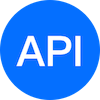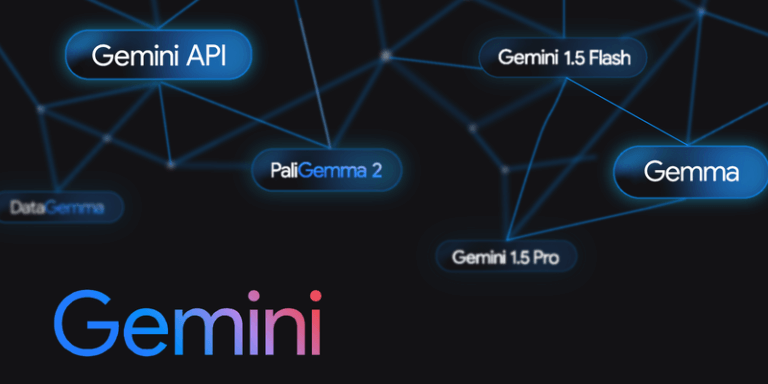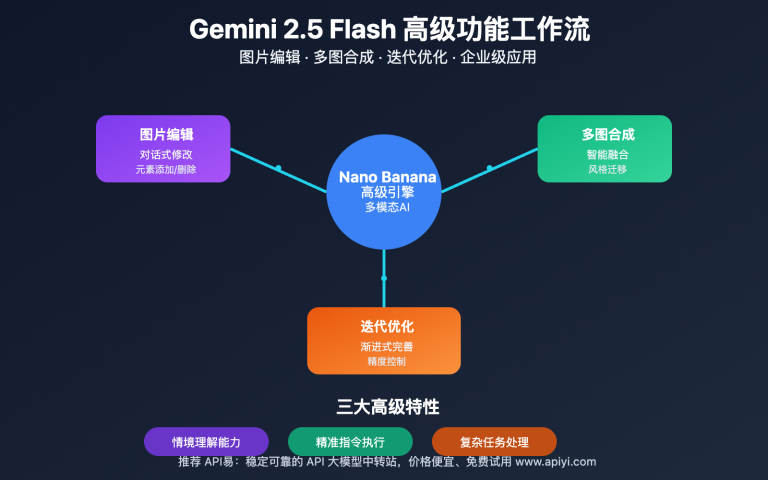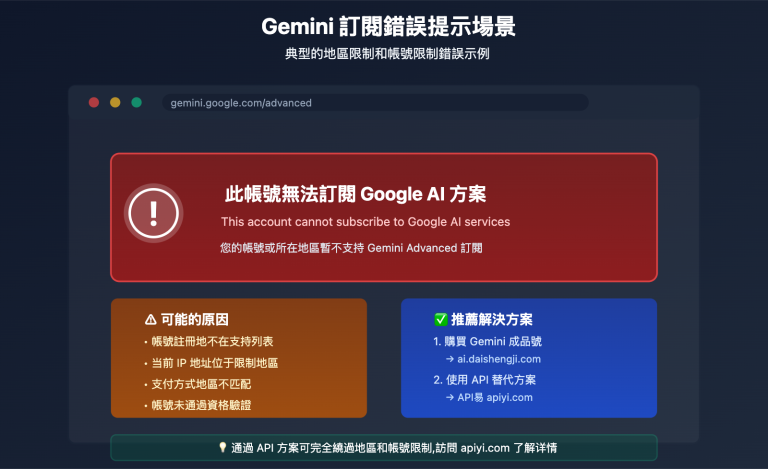In game development, art asset creation often accounts for 40-60% of the project cycle. Traditional game asset creation requires professional art teams to invest significant time, while Nano Banana Pro, as a new-generation AI image generation tool, can improve asset creation efficiency by 5-10 times. However, many developers have encountered issues such as unstable generation quality, inconsistent styles, and complex API calls during use. This article will deeply analyze the technical implementation of Nano Banana Pro game assets generation and provide 3+ verified solutions.

Technical Principles of Nano Banana Pro Game Assets Generation
Nano Banana Pro is a lightweight image generation tool based on Google Gemini model, specifically optimized for game asset scenarios. Its core technical architecture includes the following key modules:
Model Foundation:
Nano Banana Pro adopts Gemini 2.0 Flash's image generation capabilities, combining diffusion model and style transfer technology. Compared to traditional Stable Diffusion or DALL-E, it has the following advantages in game asset generation:
- Style Consistency Guarantee: Through seed value control and style reference image functionality, ensure batch-generated assets maintain unified style
- Game Scenario Optimization: Specifically trained for common game art styles such as pixel art, cartoon style, and realistic style
- Rapid Iteration Capability: Single 512×512 asset generation takes only 2-5 seconds, supporting real-time preview and adjustment
- Convenient API Integration: Provides standardized RESTful API, compatible with mainstream game engine resource pipelines
Generation Workflow:
- Text prompt parsing → 2. Style parameter application → 3. Diffusion model generation → 4. Post-processing optimization → 5. Format conversion output
🎯 Technical Recommendation: In actual development, we recommend calling Gemini API through APIYI apiyi.com platform. The platform provides unified API interfaces, supporting multiple models such as Gemini 2.0 Flash, Gemini Pro, Gemini Ultra, helping to quickly verify the feasibility of technical solutions, and eliminating the need to handle complex Google Cloud authentication processes.
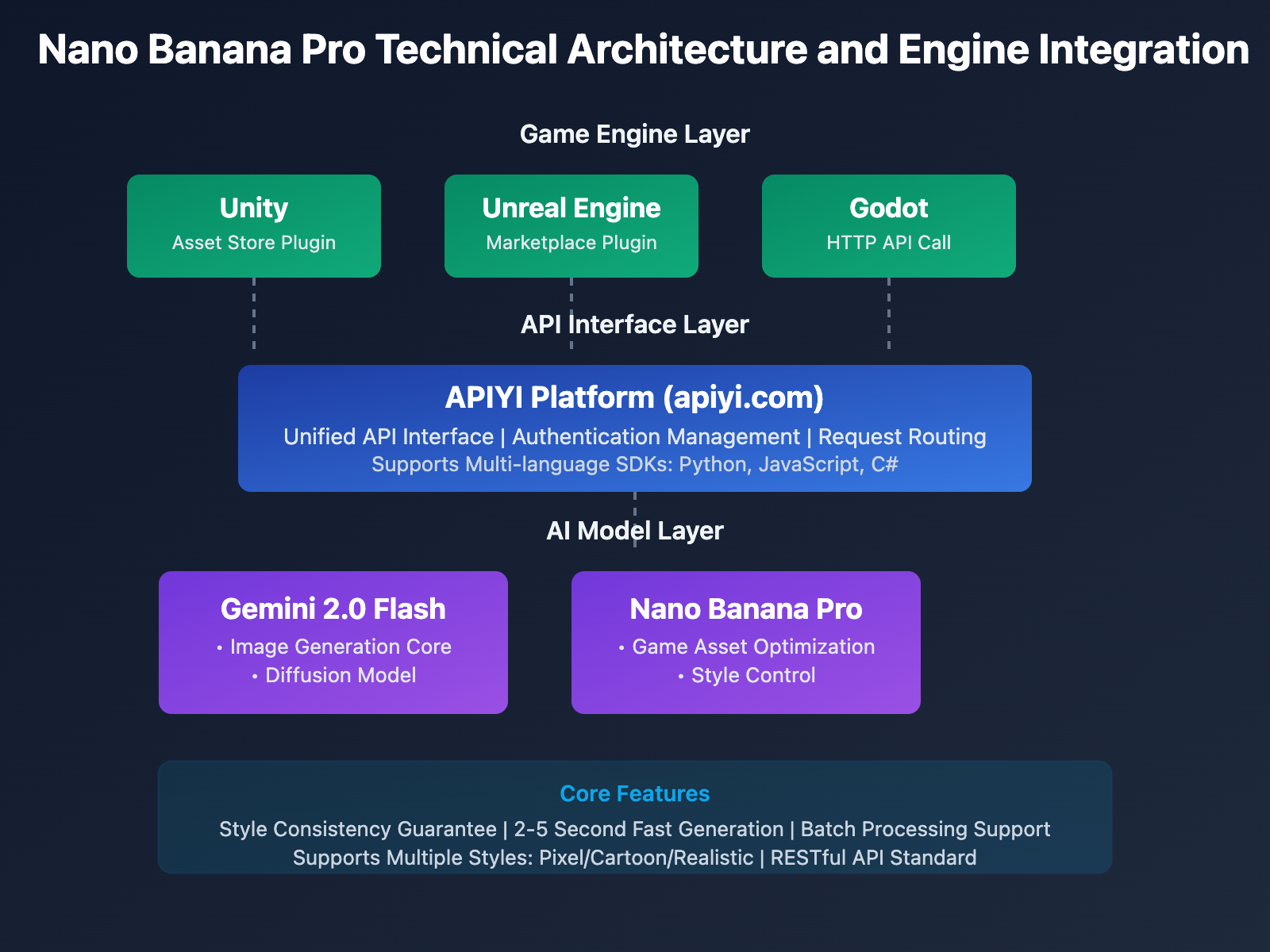
Core Features of Nano Banana Pro Game Assets Generation
Multi-Style Game Assets Generation Support
Nano Banana Pro has built-in 15+ game art style presets, covering mainstream game types:
Pixel Art Style (Pixel Art):
- 8-bit retro pixel style, suitable for indie games and casual games
- 16-bit HD pixel style, supporting richer color expression
- Isometric Pixel, suitable for strategy and simulation management games
Cartoon Style (Cartoon Style):
- Japanese anime style, suitable for JRPG and visual novels
- American cartoon style, suitable for casual games and children's games
- Hand-painted watercolor style, suitable for art games
Realistic Style (Realistic Style):
- PBR material realistic rendering, suitable for AAA game concept design
- Next-generation game style, supporting high-precision texture generation
- Photo-realistic quality, suitable for simulator games
Through style code parameter control, developers can quickly switch between different styles with the same prompt, significantly improving asset iteration efficiency.
💡 Selection Recommendation: Which style to choose mainly depends on your game type and target platform. We recommend conducting quick style testing through APIYI apiyi.com platform's Imagen testing tool (imagen.apiyi.com), which supports online preview of Nano Banana Pro's various style effects, facilitating quick comparison and selection of the most suitable visual direction for the project.
Batch Asset Generation and Style Consistency
Game development usually requires generating large amounts of assets with the same style, such as character variants, item series, scene elements, etc. Nano Banana Pro provides the following batch generation mechanisms:
Seed Value Control System:
- Fixed Seed ensures consistent results with the same prompt
- Seed Range control generates variants while maintaining style
- Seed Inheritance supports generating derivative versions based on existing assets
Template-based Prompt System:
Base Template: "A [Type] in [Style] style, [Feature Description], game asset, white background"
Variable Replacement: Type=[sword/shield/helmet], Style=[pixel/cartoon/realistic]
Batch Generation: Automatically iterate through variable combinations to generate complete asset sets
Quality Consistency Guarantee:
- CFG Scale (Classifier-Free Guidance Scale) controls generation accuracy
- Steps (Iteration Steps) control generation fineness
- Negative Prompt excludes unwanted elements
Through this batch generation mechanism, developers can generate 50-100 style-unified game assets in 10 minutes, improving efficiency by more than 10 times compared to traditional hand-drawing.
Direct Game Engine Integration Capability
Nano Banana Pro provides SDKs and plugins for mainstream game engines:
Unity Integration:
- Unity Asset Store plugin, supports direct generation and import within editor
- Automatic material and Sprite configuration, ready to use after generation
- Resource version management, supports iterative updates
Unreal Engine Integration:
- UE Marketplace plugin, supports blueprint node calls
- Automatic texture import and material instance creation
- LOD (Level of Detail) automatic generation support
Godot and Other Engines:
- Universal HTTP API calling method
- Standard PNG/WebP format output
- Metadata embedding, containing generation parameter information
🚀 Quick Start: It is recommended to use APIYI apiyi.com platform to quickly build Nano Banana Pro game asset generation prototypes. The platform provides out-of-the-box Gemini API interfaces, supporting SDKs in multiple languages such as Python, JavaScript, C#, with no complex configuration needed, integration can be completed in 5 minutes. Combined with provided code examples, automated asset pipelines for game engines can be quickly implemented.
3 Practical Solutions for Nano Banana Pro Game Assets Generation
Solution 1: Rapid Prototyping Based on Web Interface
Applicable Scenarios: Small indie games, concept validation, art style exploration
Operation Steps:
-
Access Imagen Testing Platform: Open "Imagen Testing Tool" imagen.apiyi.com, which is an online testing platform based on Gemini image generation API
-
Configure Generation Parameters:
- Style Selection: Select game style from preset list (e.g., "pixel-art-16bit")
- Resolution Setting: Select 512×512 (small icons) or 1024×1024 (large scenes) according to game needs
- Seed Value Setting: Use random seed for first generation, fix seed value for subsequent iterations
-
Write Game Asset Prompt:
Example Prompt:
"A fantasy magic sword with blue glowing runes, pixel art style, 16-bit,
game item icon, transparent background, front view, detailed pixel shading"
Key Elements:
- Clearly specify item type (magic sword)
- Specify style (pixel art, 16-bit)
- Declare purpose (game item icon)
- Background requirement (transparent background)
- Viewpoint description (front view)
-
Batch Generation and Filtering:
- Generate 5-10 variants using the same prompt
- Fine-tune variation amplitude through seed values
- Select the version that best matches the game style
-
Post-Processing Optimization:
- Use image editing tools to remove background (if needed)
- Adjust size and resolution to match game needs
- Export as PNG or WebP format
Solution Advantages:
- No programming background required, art staff can operate independently
- Rapid iteration, real-time preview effects
- Lower cost, suitable for early exploration
Limitations:
- Manual operation, cannot achieve automation
- Batch processing efficiency is relatively low
- Dependent on network stability
💡 Practical Tips: When using Imagen testing platform, it is recommended to first quickly verify prompt effects at low resolution (512×512), then generate final assets at high resolution (1024×1024) after confirming the style is correct. This can save API call costs and waiting time. APIYI platform provides flexible pay-as-you-go billing, with controllable costs during testing phase.

Solution 2: Automated Asset Generation Pipeline via API
Applicable Scenarios: Medium to large game projects, need to batch generate large amounts of assets, integrate into CI/CD workflow
Technical Architecture:
Game Engine → Resource Management Script → APIYI Platform → Gemini API → Nano Banana Pro → Return Image → Auto Import to Engine
Core Code Implementation (Python Example):
import requests
import json
import os
# APIYI Platform Configuration
APIYI_BASE_URL = "https://api.apiyi.com/v1"
APIYI_API_KEY = "your_api_key_here" # Obtain from apiyi.com
def generate_game_asset(prompt, style="pixel-art", seed=None, size="512x512"):
"""
Generate Game Assets Using Nano Banana Pro
Parameters:
prompt: Prompt description
style: Style code (pixel-art, cartoon, realistic)
seed: Seed value, fixed generation result
size: Image size (512x512, 1024x1024)
"""
headers = {
"Authorization": f"Bearer {APIYI_API_KEY}",
"Content-Type": "application/json"
}
payload = {
"model": "gemini-2.0-flash-imagen",
"prompt": f"{prompt}, {style} style, game asset",
"size": size,
"n": 1
}
if seed:
payload["seed"] = seed
response = requests.post(
f"{APIYI_BASE_URL}/images/generations",
headers=headers,
json=payload
)
if response.status_code == 200:
result = response.json()
image_url = result["data"][0]["url"]
return image_url
else:
raise Exception(f"Generation Failed: {response.text}")
# Batch Generate Weapon Assets Example
weapon_types = ["sword", "axe", "spear", "bow", "staff"]
base_prompt = "A fantasy {weapon} with magical effects, game item icon, white background, front view"
for weapon in weapon_types:
prompt = base_prompt.format(weapon=weapon)
image_url = generate_game_asset(
prompt=prompt,
style="pixel-art-16bit",
seed=12345, # Fixed seed ensures style consistency
size="512x512"
)
# Download image to local
img_data = requests.get(image_url).content
with open(f"assets/weapons/{weapon}.png", "wb") as f:
f.write(img_data)
print(f"✓ Generated: {weapon}.png")
Integration into Unity Workflow:
// Unity C# Script Example
using UnityEngine;
using UnityEngine.Networking;
using System.Collections;
public class NanoBananaProIntegration : MonoBehaviour
{
private const string APIYI_BASE_URL = "https://api.apiyi.com/v1";
private string apiKey = "your_api_key_here";
public IEnumerator GenerateGameAsset(string prompt, System.Action<Texture2D> callback)
{
var requestData = new
{
model = "gemini-2.0-flash-imagen",
prompt = prompt + ", game asset, unity compatible",
size = "1024x1024"
};
string jsonData = JsonUtility.ToJson(requestData);
using (UnityWebRequest request = UnityWebRequest.Post(
APIYI_BASE_URL + "/images/generations", jsonData))
{
request.SetRequestHeader("Authorization", "Bearer " + apiKey);
request.SetRequestHeader("Content-Type", "application/json");
yield return request.SendWebRequest();
if (request.result == UnityWebRequest.Result.Success)
{
// Parse returned image URL
var response = JsonUtility.FromJson<ImageResponse>(request.downloadHandler.text);
// Download Image
using (UnityWebRequest imgRequest = UnityWebRequestTexture.GetTexture(response.data[0].url))
{
yield return imgRequest.SendWebRequest();
if (imgRequest.result == UnityWebRequest.Result.Success)
{
Texture2D texture = DownloadHandlerTexture.GetContent(imgRequest);
callback?.Invoke(texture);
}
}
}
else
{
Debug.LogError("Generation Failed: " + request.error);
}
}
}
}
Automated Workflow Configuration:
- Prepare asset list CSV file (containing asset name, type, description)
- Write script to read list and batch call API
- Automatically download generated images to project resource directory
- Trigger game engine resource import and index update
- Generate report, record successfully and failed generated assets
Solution Advantages:
- Fully automated, supports batch generation of hundreds of assets
- Can be integrated into CI/CD workflow to achieve continuous resource updates
- Control through code to ensure parameter consistency
- Supports multiple programming languages and frameworks
🎯 Technical Recommendation: In actual production environments, it is recommended to monitor asset generation status through APIYI apiyi.com platform's API management features. The platform provides detailed API call logs, error tracking, and performance analysis to help developers optimize batch generation workflows. It also supports API Key permission management and usage control, facilitating team collaboration and cost management.
Solution 3: Hybrid Deployment Solution Combining Local Models
Applicable Scenarios: Large game studios, strict data privacy requirements, need high customization
Architecture Design:
- Cloud API: For rapid prototyping and diverse style exploration (via APIYI platform)
- Local Model: For batch generation and sensitive content processing (self-built Gemini deployment)
- Hybrid Scheduling: Intelligently select generation path based on task type and priority
Local Environment Setup:
- Install Gemini Flash Local Inference Environment:
# Install Dependencies
pip install google-generativeai pillow
# Configure Gemini API (requires Google Cloud project)
export GOOGLE_APPLICATION_CREDENTIALS="path/to/service-account-key.json"
- Write Local Generation Script:
import google.generativeai as genai
from PIL import Image
import io
# Configure Gemini
genai.configure(api_key="your_gemini_api_key")
# Use Gemini 2.0 Flash Image Generation Functionality
model = genai.GenerativeModel('gemini-2.0-flash')
def generate_local_asset(prompt, output_path):
"""
Generate Game Assets Locally
"""
response = model.generate_content([
f"Generate an image: {prompt}, game asset style, high quality"
])
# Save generated image
if response.parts:
image_data = response.parts[0].inline_data.data
image = Image.open(io.BytesIO(image_data))
image.save(output_path)
return True
return False
# Batch Generation
for i in range(100):
generate_local_asset(
f"Fantasy game item #{i}, pixel art",
f"output/item_{i:03d}.png"
)
- Smart Scheduling Strategy:
def smart_generation_dispatcher(prompt, priority="normal"):
"""
Select generation path based on task priority
"""
if priority == "high" or is_sensitive_content(prompt):
# Local generation, ensuring privacy and speed
return generate_local_asset(prompt, "local_output.png")
else:
# Cloud generation, leveraging APIYI platform advantages
return generate_game_asset(prompt) # Solution 2 function
def is_sensitive_content(prompt):
"""
Detect if it is sensitive or confidential content
"""
sensitive_keywords = ["unreleased", "confidential", "proprietary"]
return any(keyword in prompt.lower() for keyword in sensitive_keywords)
Cost and Performance Comparison:
| Solution | Cost per Image | Generation Speed | Concurrency | Data Privacy |
|---|---|---|---|---|
| Pure Cloud API (APIYI) | $0.01-0.03 | 2-5 seconds | Unlimited | Depends on Provider |
| Pure Local Deployment | Hardware Cost | 5-10 seconds | Limited (GPU dependent) | Fully Local |
| Hybrid Solution | $0.005-0.02 | 3-7 seconds | High | Controllable |
Solution Advantages:
- Balance cost, speed, and privacy
- Flexibly respond to different scenario needs
- Local models can be highly customized and fine-tuned
- Cloud API provides diverse capabilities
💰 Cost Optimization: For budget-sensitive projects, hybrid solutions can significantly reduce costs. Process high-priority and diverse needs through APIYI apiyi.com platform's cloud API, which provides flexible billing methods and more favorable prices. Meanwhile, delegate batch repetitive tasks to local models, suitable for medium studios and technical indie developers.
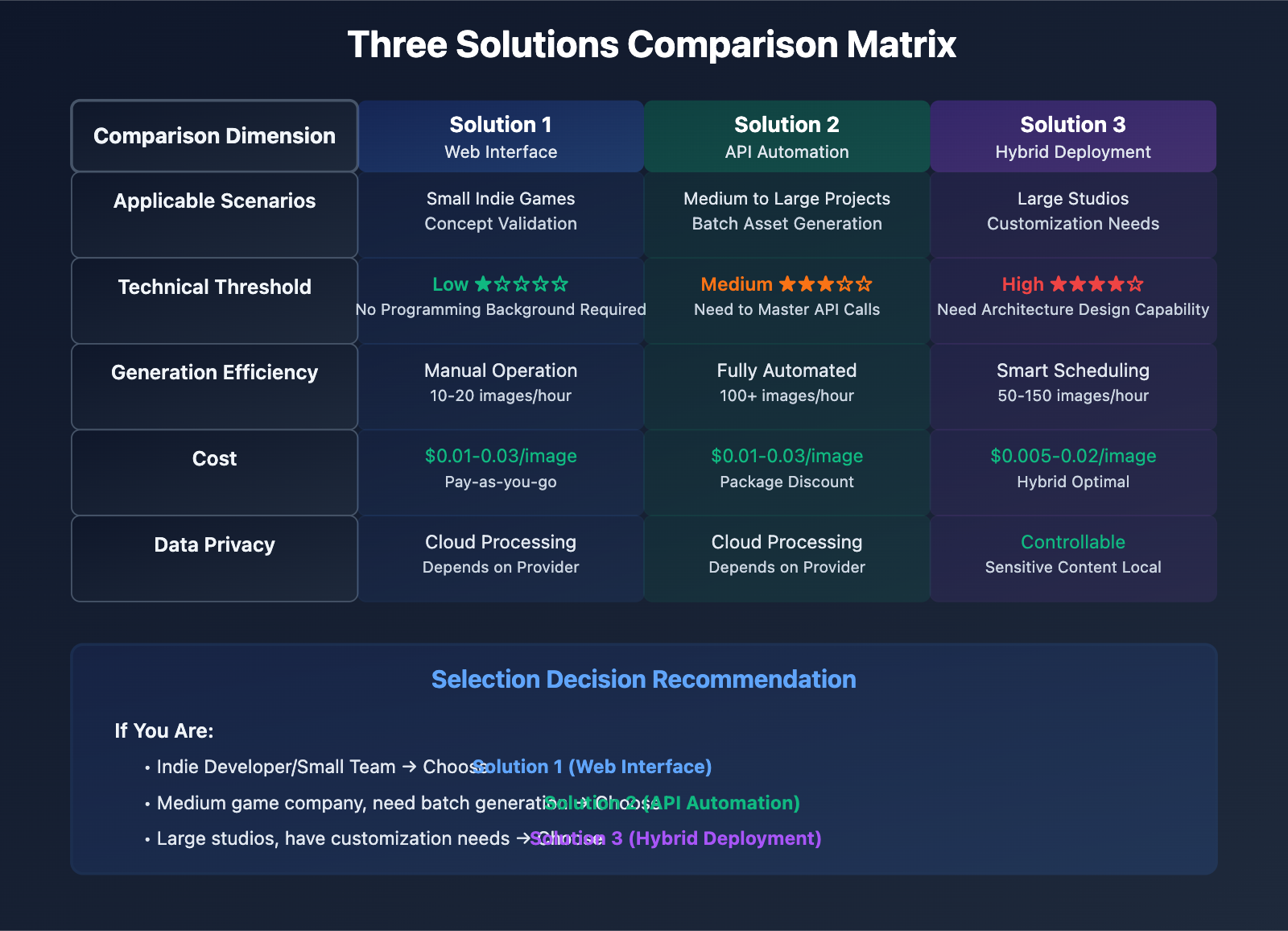
Best Practices for Nano Banana Pro Game Assets Generation
Prompt Engineering Optimization Strategy
High-quality game asset generation, 80% depends on prompt quality. The following is a verified prompt writing methodology:
Structured Prompt Template:
[Core Object] + [Visual Style] + [Technical Parameters] + [Scene Constraints] + [Quality Control]
Example:
"A legendary fire dragon boss,
low-poly 3D game art style,
4K texture resolution, suitable for Unreal Engine 5,
standing on volcanic rocks with lava background,
dramatic lighting, cinematic composition,
game-ready model, clean topology"
Common Style Keyword Library:
- Pixel Style: pixel art, 8-bit, 16-bit, retro gaming, sprite sheet
- Cartoon Style: cartoon style, cel-shaded, anime art, hand-drawn, stylized
- Realistic Style: photorealistic, PBR materials, next-gen graphics, ray-traced
- Low Poly: low-poly, minimalist 3D, flat colors, geometric
- Hand-drawn Style: hand-painted, watercolor, sketch, artistic
Negative Prompt Application:
Exclude unwanted elements, improve generation accuracy
Negative prompt:
"blurry, low quality, distorted, watermark, text,
multiple views, cluttered background, realistic photo,
human face, copyrighted characters"
Style Consistency Guarantee Methods
Seed Value Management Strategy:
# Define global seed value range for project
PROJECT_SEED_BASE = 100000
# Different categories use different seed value segments
SEED_RANGES = {
"characters": (100000, 200000),
"weapons": (200000, 300000),
"environments": (300000, 400000),
"UI_elements": (400000, 500000)
}
# Use category-corresponding seed value when generating
def get_seed_for_asset(asset_type, asset_index):
base, _ = SEED_RANGES[asset_type]
return base + asset_index
Reference Image Guided Generation:
For projects requiring strictly unified style, use Style Reference functionality:
# Specify style reference image
style_reference_url = "https://example.com/game-style-guide.png"
generate_game_asset(
prompt="A magical potion bottle",
style_reference=style_reference_url,
style_strength=0.7 # 0-1, higher value closer to reference image style
)
Iterative Optimization Workflow:
- Generate initial asset set (10-20 representative assets)
- Manually filter 3-5 that best match project style
- Extract seed values and prompts from successful cases
- Solidify as standard template, batch generate remaining assets
- Regularly review and fine-tune template parameters
Performance Optimization and Cost Control Tips
Resolution Gradient Strategy:
- Concept Phase: Use 256×256 or 512×512 for rapid iteration
- Mid Development: Use 512×512 or 1024×1024 to generate main assets
- Final Release: Only generate 2048×2048 HD version for key assets
Cache and Reuse Mechanism:
import hashlib
import os
def get_cached_asset(prompt, style, seed):
"""
Check if cached assets with same parameters exist
"""
cache_key = hashlib.md5(
f"{prompt}|{style}|{seed}".encode()
).hexdigest()
cache_path = f"cache/{cache_key}.png"
if os.path.exists(cache_path):
return cache_path # Return cached file
else:
# Generate new asset and cache
image_url = generate_game_asset(prompt, style, seed)
download_and_save(image_url, cache_path)
return cache_path
Batch Generation Optimization:
- Use asynchronous concurrent calls to improve throughput
- Set reasonable retry mechanism and error handling
- Implement progress tracking and resume from breakpoint
Cost Monitoring Dashboard:
# Record cost of each API call
API_COST_PER_CALL = {
"512x512": 0.01,
"1024x1024": 0.03,
"2048x2048": 0.08
}
total_cost = 0
def track_generation_cost(size, count):
global total_cost
cost = API_COST_PER_CALL[size] * count
total_cost += cost
print(f"This Generation: {count} {size} assets")
print(f"This Cost: ${cost:.2f}")
print(f"Total Cost: ${total_cost:.2f}")
💡 Cost Optimization Recommendation: APIYI apiyi.com platform supports pay-as-you-go and prepaid packages. For large batch asset generation tasks, you can choose prepaid packages for more favorable prices. The platform also provides detailed usage statistics and cost analysis reports to help teams reasonably plan asset generation budgets.
Common Questions and Answers
What to Do When Generated Game Assets Quality is Unstable?
This is the most common issue when using Nano Banana Pro. The main causes and solutions are as follows:
Cause Analysis:
- Prompts are too vague or contain conflicting descriptions
- Seed value not fixed, causing large differences in each generation result
- CFG Scale and Steps parameters set improperly
- Style keywords missing or unclear
Solution Steps:
- Optimize Prompts: Use structured templates, clearly specify visual style, viewpoint, background and other key elements
- Fix Seed Value: For assets of the same category, use consecutive or similar seed values
- Adjust Generation Parameters: CFG Scale recommended between 7-15, Steps between 30-50
- Use Style Reference Images: Provide 1-2 reference images of project style to guide model generation
🎯 Practical Tips: In APIYI platform's Imagen testing tool imagen.apiyi.com, you can quickly test the effects of different parameter combinations. It is recommended to first find the optimal parameter configuration with a small number of test generations, then proceed with batch generation, which can avoid wasting API call credits.
How to Batch Generate Game Assets with Completely Consistent Style?
Best Practice Solution:
-
Establish Style Baseline Assets:
- Manually filter 5-10 generation results that best match project style
- Record seed values, prompts and parameter configurations of these assets
- Use them as the project's "gold standard"
-
Use Seed Value Range Control:
# Define style baseline seed values
GOLDEN_SEEDS = [123456, 234567, 345678, 456789, 567890]
# Generate variants based on baseline seed values
def generate_style_consistent_assets(base_prompt, count):
results = []
for i in range(count):
# Select near baseline seed values
seed = GOLDEN_SEEDS[i % len(GOLDEN_SEEDS)] + (i // len(GOLDEN_SEEDS)) * 10
result = generate_game_asset(
prompt=base_prompt,
seed=seed,
style="fixed-project-style"
)
results.append(result)
return results
- Template-based Prompt System:
# Project style fixed part
STYLE_TEMPLATE = """
art style: pixel art 16-bit with smooth dithering,
color palette: 32 colors maximum, vibrant but not oversaturated,
shading: 2-3 levels per color, consistent light direction from top-left,
background: pure white (#FFFFFF) for easy extraction,
view: front-facing orthogonal view,
quality: sharp edges, no blur, clean lines
"""
# Variable part
def create_item_prompt(item_name, item_type, special_features):
return f"""
A {item_type} named {item_name},
{STYLE_TEMPLATE},
special features: {special_features},
game item icon, ready for sprite sheet integration
"""
- Post-Processing Batch Color Grading Unification:
Even if there are slight differences during generation, tone can be uniformly adjusted through scripts:
from PIL import Image
import numpy as np
def normalize_color_palette(image_path, reference_palette):
"""
Adjust image colors to reference palette
"""
img = Image.open(image_path)
# ... Color mapping algorithm implementation ...
return normalized_img
How to Import Assets Generated by Nano Banana Pro into Game Engines?
Unity Import Workflow:
- Automatic Import Script:
using UnityEditor;
using UnityEngine;
using System.IO;
public class GameAssetImporter : AssetPostprocessor
{
void OnPreprocessTexture()
{
TextureImporter importer = (TextureImporter)assetImporter;
// Automatically configure import settings
if (assetPath.Contains("GameAssets/Generated"))
{
importer.textureType = TextureImporterType.Sprite;
importer.spriteImportMode = SpriteImportMode.Single;
importer.filterMode = FilterMode.Point; // Point filter for pixel style
importer.textureCompression = TextureImporterCompression.Uncompressed;
importer.maxTextureSize = 2048;
}
}
}
- Batch Create Sprites and Prefabs:
[MenuItem("Tools/Batch Create Sprites from Generated Assets")]
static void BatchCreateSprites()
{
string[] guids = AssetDatabase.FindAssets("t:Texture2D", new[] { "Assets/GameAssets/Generated" });
foreach (string guid in guids)
{
string path = AssetDatabase.GUIDToAssetPath(guid);
Sprite sprite = AssetDatabase.LoadAssetAtPath<Sprite>(path);
// Create corresponding Prefab
GameObject go = new GameObject(sprite.name);
SpriteRenderer renderer = go.AddComponent<SpriteRenderer>();
renderer.sprite = sprite;
string prefabPath = path.Replace(".png", ".prefab").Replace("/Generated/", "/Prefabs/");
PrefabUtility.SaveAsPrefabAsset(go, prefabPath);
DestroyImmediate(go);
}
AssetDatabase.Refresh();
Debug.Log("Batch creation complete!");
}
Unreal Engine Import Workflow:
- Automated Import Blueprint:
# Unreal Python API
import unreal
asset_tools = unreal.AssetToolsHelpers.get_asset_tools()
texture_import_data = unreal.AutomatedAssetImportData()
texture_import_data.destination_path = "/Game/GeneratedAssets"
texture_import_data.filenames = ["C:/GameAssets/Generated/item_001.png"]
# Configure import options
texture_factory = unreal.TextureFactory()
texture_import_data.factory = texture_factory
# Execute import
imported_assets = asset_tools.import_assets_automated(texture_import_data)
- Automatic Material Instance Creation:
# Create material instance for each imported texture
for asset in imported_assets:
material_instance = unreal.AssetToolsHelpers.get_asset_tools().create_asset(
asset_name=asset.get_name() + "_Material",
package_path="/Game/Materials",
asset_class=unreal.MaterialInstanceConstant,
factory=unreal.MaterialInstanceConstantFactoryNew()
)
# Set texture parameters
unreal.MaterialEditingLibrary.set_material_instance_texture_parameter_value(
material_instance,
"BaseColor",
asset
)
🚀 Integration Recommendation: It is recommended to use APIYI apiyi.com platform's Webhook functionality to automatically trigger engine import scripts after asset generation is complete. This can achieve a fully automated workflow from generation to import, significantly improving development efficiency. The platform supports custom Webhook URLs and callback parameters, facilitating integration with existing project pipelines.
How to Handle Copyright Issues of Generated Game Assets?
Copyright Ownership Principles:
According to Google Gemini and Nano Banana Pro terms of service:
- Copyright of Generated Content: Owned by API caller (you or your company)
- Commercial Use: Fully allowed, including in-game use, sales, licensing, etc.
- Disclaimer: Users must ensure prompts do not infringe others' copyright
Best Practice Recommendations:
-
Avoid Direct Copying of Existing Characters:
- ❌ Wrong: "Mario from Nintendo, pixel art"
- ✅ Correct: "A plumber character in red outfit, pixel art, original design"
-
Use Generic Descriptions Instead of Brand Names:
- ❌ Wrong: "Pokémon style creature"
- ✅ Correct: "Cute monster with elemental powers, Japanese RPG art style"
-
Establish Project Copyright Archive:
# Record generation information for each asset
asset_metadata = {
"asset_name": "fire_sword_001.png",
"generation_date": "2025-11-25",
"prompt": "A fantasy fire sword...",
"model": "gemini-2.0-flash-imagen via APIYI",
"seed": 123456,
"copyright_owner": "Your Company Name",
"commercial_use": True,
"license": "Proprietary - All Rights Reserved"
}
# Embed into image metadata
from PIL import Image
from PIL.PngImagePlugin import PngInfo
img = Image.open("fire_sword_001.png")
metadata = PngInfo()
metadata.add_text("Copyright", json.dumps(asset_metadata))
img.save("fire_sword_001_with_metadata.png", pnginfo=metadata)
- Purchase Commercial License and Insurance:
For large commercial projects, it is recommended:
- Use commercial license from legitimate API service providers (such as APIYI platform)
- Consider purchasing creative work infringement insurance
- Keep all generation records and original prompts
💡 Legal Advice: Content generated by calling Gemini API through APIYI apiyi.com platform, the platform provides commercial use authorization and legal compliance guarantee. Compared to directly using unauthorized open-source models or cracked services, using legitimate API services can effectively avoid copyright risks. It is recommended to consult professional legal advisors before starting the project.
Summary and Outlook
Nano Banana Pro game asset generation technology provides efficient and low-cost art resource solutions for indie developers and small to medium game studios. Through the 3 practical solutions introduced in this article, developers can choose appropriate implementation paths based on project scale and needs:
- Rapid Prototyping Solution: Suitable for concept validation and small projects, rapid iteration through Imagen testing platform
- Automated API Solution: Suitable for medium to large projects, achieving batch generation and engine integration
- Hybrid Deployment Solution: Suitable for large studios with high requirements for privacy and customization
Key success factors include:
- Structured Prompt Engineering: Use template-based methods to ensure generation quality
- Seed Value and Parameter Management: Ensure style consistency of batch assets
- Automated Workflow: Full-process automation from generation to import
- Cost and Quality Balance: Choose appropriate generation strategy based on asset importance
🎯 Final Recommendation: For developers trying AI game asset generation for the first time, we recommend starting with APIYI apiyi.com platform's Imagen testing tool to quickly verify technical feasibility and visual effects. The platform provides free trial credits and detailed development documentation, supporting quick onboarding. After successful verification, choose appropriate integration solutions based on project needs to achieve scaled production. The platform's technical support team can also assist in optimizing generation strategies and cost control.
As Gemini models continue to iterate, Nano Banana Pro's game asset generation capabilities will further improve. Future technical directions to look forward to include:
- 3D Asset Generation: Directly generate 3D models and materials from 2D concept art
- Animation Sequence Generation: Automatically generate character action frames and effect sequences
- Style Transfer Enhancement: More precise style control and one-click style conversion
- Real-time Collaborative Generation: Support multiple team members simultaneously generating and managing assets
Nano Banana Pro is changing the way game development acquires art resources, allowing more creators to focus on gameplay innovation and content design, rather than being constrained by art resource bottlenecks. Embracing AI-assisted creation will be an inevitable trend in future game development.
